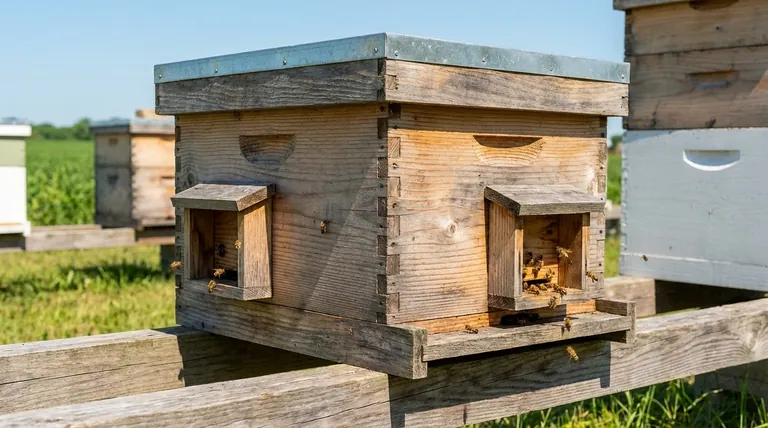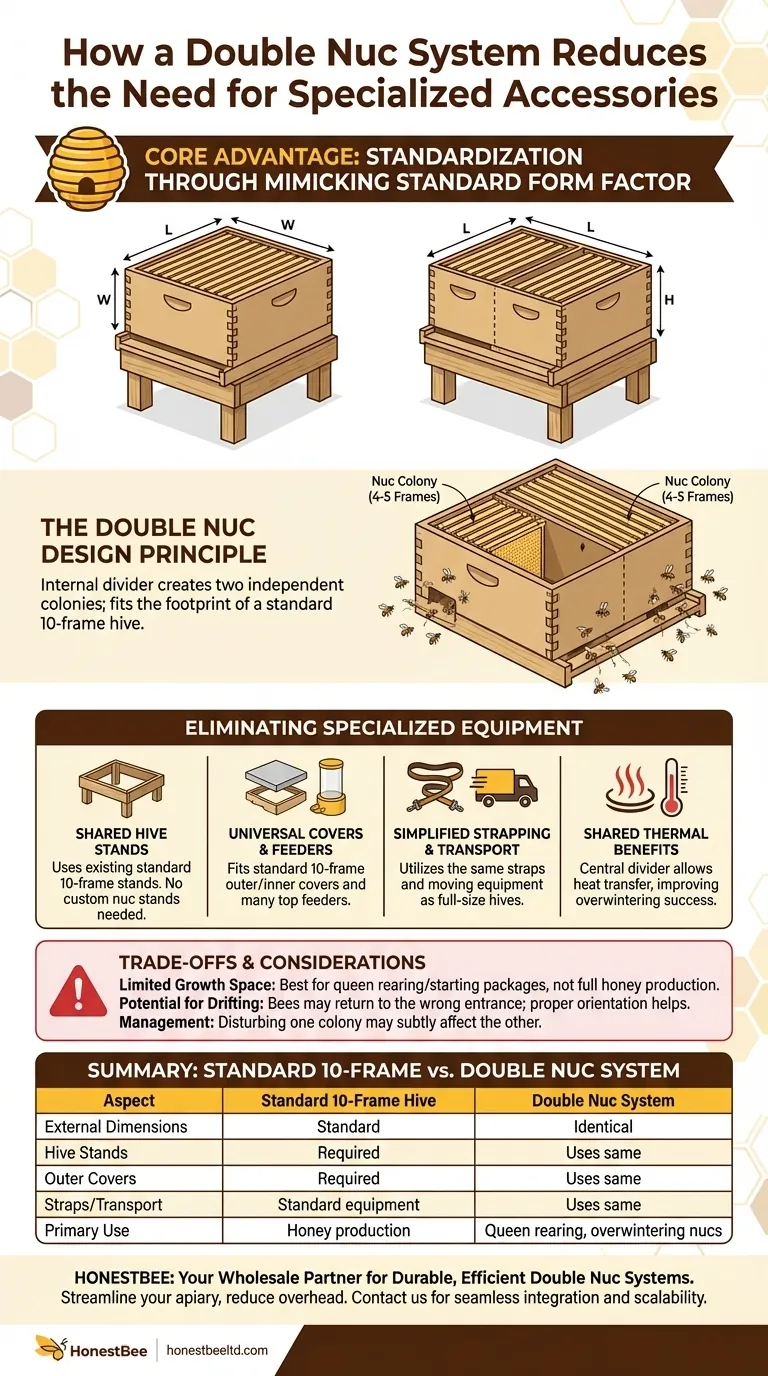At its core, a double nuc system reduces the need for specialized accessories by being designed to match the external dimensions of a standard 10-frame hive. This allows beekeepers to use their existing, common equipment like hive stands, outer covers, and straps, eliminating the cost and complexity of managing separate gear for smaller nucleus colonies.
The fundamental advantage of a double nuc is standardization. By housing two small, independent colonies within a single box that has the footprint of a standard 10-frame hive, it integrates seamlessly into your existing apiary workflow and equipment inventory.

The Principle: Mimicking the Standard Form Factor
A double nuc is an intelligent workaround for the problem of managing multiple hive sizes. It's a system designed for efficiency.
The 10-Frame Footprint
The entire system is built around one concept: making a box that holds two small colonies look and act like one large one from the outside. Its external length and width are identical to a standard 10-frame deep hive body.
The Internal Divider
A solid center divider board splits the box internally, creating two separate, self-contained compartments. Each compartment typically holds four or five frames, creating two distinct nucleus colonies.
Independent Entrances
To ensure the two colonies remain separate, the box features two small entrances. These are usually drilled in opposite corners of the hive body to minimize the chance of bees drifting from one colony into the other.
How This Eliminates Specialized Equipment
This design directly translates into cost and labor savings by allowing you to reuse the most common beekeeping hardware.
Shared Hive Stands
Because the double nuc box has a standard 10-frame base, it sits perfectly on any hive stand you already use for your production hives. You do not need to build or buy smaller, custom-sized stands for your nucs.
Universal Covers and Feeders
Standard 10-frame telescoping outer covers and inner covers fit directly on top. This provides better weather protection and insulation than typical nuc lids and simplifies your inventory. Many top feeders designed for 10-frame hives will also work.
Simplified Strapping and Transport
When you need to secure hives for weather or move them, you can use the same straps and moving equipment that you use for your full-size hives. This makes your entire apiary operation more uniform and predictable.
Shared Thermal Benefits
While not an accessory, the two colonies also share warmth. The central divider allows heat to transfer between the colonies, improving their ability to regulate temperature and increasing their chances of successfully overwintering.
Understanding the Trade-offs
While highly efficient, the double nuc system is a specialized tool with specific limitations. It is not a direct replacement for a full-size hive.
Limited Growth Space
Each colony only has four or five frames to expand. This is by design, as its purpose is for raising queens or starting new colonies, but it means you must be vigilant about swarm prevention and be ready to move the growing colony into a larger hive.
Potential for Drifting
Even with entrances on opposite sides, the colonies are in close proximity. This can lead to a slight increase in "drifting," where bees return to the wrong entrance. Proper orientation and distinct markings can help mitigate this.
Management Considerations
Inspecting or manipulating one colony can subtly disturb the adjacent one, as they share a single physical box. This is a minor issue but is different from working two separate nuc boxes.
Making the Right Choice for Your Apiary
A double nuc is a tool for a specific job. Its value depends entirely on your beekeeping goals.
- If your primary focus is cost savings and operational efficiency: A double nuc system is an excellent choice to streamline raising queens or starting packages without investing in a separate set of nuc-sized equipment.
- If your primary focus is overwintering smaller colonies: The shared warmth and standard, well-insulated covers make it one of the most effective methods for helping nucs survive the winter.
- If your primary focus is maximum honey production: You should use a standard 10-frame hive configuration, as the double nuc is built for colony development, not surplus honey storage.
By integrating nuc management into a standardized 10-frame system, the double nuc empowers you to run a more efficient and scalable apiary.
Summary Table:
| Aspect | Standard 10-Frame Hive | Double Nuc System |
|---|---|---|
| External Dimensions | Standard | Identical to 10-Frame |
| Hive Stands | Required | Uses the same stands |
| Outer Covers | Required | Uses the same covers |
| Straps/Transport | Standard equipment | Uses the same equipment |
| Primary Use | Honey production | Queen rearing, overwintering nucs |
Ready to simplify your beekeeping operation?
As a trusted wholesale supplier to commercial apiaries and equipment distributors, HONESTBEE provides the durable, efficient double nuc systems that help you scale your business. Our equipment is designed for beekeepers who value standardization and cost-effectiveness.
Contact HONESTBEE today to learn how our double nuc systems can integrate seamlessly into your apiary and reduce your equipment overhead.
Visual Guide

Related Products
- 5 Frame Wooden Nuc Box for Beekeeping
- Twin Queen Styrofoam Honey Bee Nucs Mating and Breeding Box
- Styrofoam Mini Mating Nuc Box with Frames Feeder Styrofoam Bee Hives 3 Frame Nuc Box
- Automatic Heat Preservation 6 Frame Pro Nuc Box for Honey Bee Queen Mating
- Portable Bee Mating Hive Boxes Mini Mating Nucs 8 Frames for Queen Rearing
People Also Ask
- What is the most common type of standard nuc? The 5-Frame Nuc Explained
- What is the purpose of having a nuc in beekeeping? Build a Resilient & Productive Apiary
- What is the advantage of overwintering a nucleus? A Strategic Asset for Beekeeping Success
- What are the benefits of moving nuclei around the apiary? Master Strategic Hive Management
- What are the benefits of using nucs for beginning beekeepers? Ensure a Successful First Hive with a Head Start



















